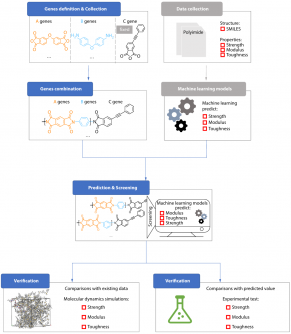A research team from the East China University of Science and Technology has introduced an innovative AI-assisted materials-genome approach that significantly enhances the design of polyimide films. These films are crucial in industries such as aerospace, flexible electronics, and micro-display technologies due to their excellent thermal stability and insulation properties. The team’s findings, published online on September 2, 2025, in the Chinese Journal of Polymer Science, showcase a method capable of rapidly designing high-performance thermosetting polyimides.
Traditional methods of optimizing polyimide films often face challenges, as increasing one mechanical property can detrimentally affect another. The conventional trial-and-error synthesis is time-consuming and costly, limiting exploration within complex molecular spaces. The newly developed strategy leverages machine learning to establish structure–property relationships directly from data, marking a notable advancement in materials science.
The research team employed a machine-learning model that predicts three significant mechanical parameters: Young’s modulus, tensile strength, and elongation at break. This model was trained on over 120 experimental datasets of polyimide films, allowing it to evaluate thousands of candidate structures. It successfully identified a new formulation, PPI-TB, which outperformed established polyimides in terms of mechanical performance.
Innovative Approach to Polymer Design
The model utilized Gaussian process regression (GPR) and treated various structural fragments—such as dianhydride, diamine, and end-capping units—as “genes.” This approach defined a vast chemical space comprising 1,720 phenylethynyl-terminated polyimides (PPIs). With a predictive accuracy of approximately R² 0.70–0.74 for all three mechanical metrics, the model was instrumental in scoring each candidate for comprehensive mechanical performance.
Molecular dynamics simulations confirmed the model’s predictions, revealing that PPI-TB (with gene combination A4/B32) exhibited superior modulus at 3.48 GPa, along with enhanced toughness and strength indicators compared to benchmark systems such as PETI-1 and O-O-3. Further experimental validation on representative PPIs demonstrated a robust correlation between predicted and actual results.
The study also conducted analyses on gene importance, uncovering key design principles that enhance the performance of polyimides. For instance, the presence of conjugated aromatic structures was found to improve stiffness, while heteroatoms and heterocycles enhanced molecular interactions. Additionally, flexible silicon- or sulfur-containing units contributed positively to elongation properties.
Transforming Polymer Innovation
Prof. Li-Quan Wang, a corresponding author of the study, emphasized the transformative potential of this approach, stating, “By translating polymer fragments into genetic-like descriptors, we can treat molecular design like decoding a genome.” He noted that machine learning not only predicts performance but also identifies the chemical “genes” responsible for it. This synergy between data science and chemistry opens up new avenues for material exploration that would typically take decades using traditional methods.
The AI-driven materials-genome strategy presents a scalable framework for designing polymers with tailored combinations of stiffness, strength, and flexibility. These characteristics are vital for applications in microelectronics, aerospace composites, and flexible circuit substrates. By significantly reducing the time and cost associated with experimental iterations, this method paves the way for rapid advancements in polymer technology.
Looking ahead, the workflow developed by the research team could be adapted for other high-performance polymer classes. This adaptability promises to guide the creation of lightweight, durable, and thermally stable materials that will play a pivotal role in the future of electronic and aerospace technologies.
The project received funding from the National Key R&D Program of China and the National Natural Science Foundation of China, underlining the importance of collaborative efforts in advancing scientific research.
As the field of materials science continues to evolve, the integration of AI into polymer design represents a significant leap forward, setting a new standard for how materials are developed in the 21st century.







